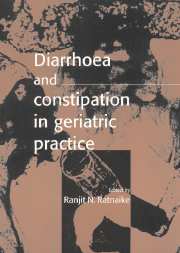Book contents
- Frontmatter
- Contents
- List of contributors
- Preface
- Acknowledgments
- Foreword by Gary R. Andrews
- I Defences of the aging gastrointestinal tract
- II Diarrhoea
- 3 Pathophysiology of diarrhoea
- 4 History and physical examination
- 5 The investigation of diarrhoea
- 6 Faecal incontinence
- 7 Drug-induced diarrhoea
- 8 Aetiology of infectious diarrhoea
- 9 Specific infectious conditions
- 10 An overview of management of infectious diarrhoea
- III Noninfectious clinical entities
- IV Constipation
- V Perspectives of altered bowel function
- Index
8 - Aetiology of infectious diarrhoea
Published online by Cambridge University Press: 17 August 2009
- Frontmatter
- Contents
- List of contributors
- Preface
- Acknowledgments
- Foreword by Gary R. Andrews
- I Defences of the aging gastrointestinal tract
- II Diarrhoea
- 3 Pathophysiology of diarrhoea
- 4 History and physical examination
- 5 The investigation of diarrhoea
- 6 Faecal incontinence
- 7 Drug-induced diarrhoea
- 8 Aetiology of infectious diarrhoea
- 9 Specific infectious conditions
- 10 An overview of management of infectious diarrhoea
- III Noninfectious clinical entities
- IV Constipation
- V Perspectives of altered bowel function
- Index
Summary
BACTERIA
Enteric infections are a major cause of acute diarrhoea in the elderly, due to diminished systemic and local gastrointestinal defences (see Chapters 1 and 2). Diarrhoea due to the ingestion of a pathogen is not invariable and depends on the number of organisms ingested (inoculum), their virulence and the efficiency of the host's defences. Other factors which predispose to diarrhoea in the elderly include current illnesses, poor personal and domestic hygiene as a result of mental and physical infirmities, and environmental constraints such as inadequate facilities for food preparation and preservation.
The elderly in institutions are at risk from common-source outbreaks of diarrhoea such as food poisoning and person to person transmission of enteric pathogens. In the elderly, nosocomial infections are common and pathogens frequently identified are Clostridium difficile and Salmonella sp. In a study on diarrhoea in the elderly from Britain, Campylobacter jejuni and nontyphoidal Salmonella and Shigella sp. were the most common organisms isolated.
The mechanisms by which bacteria cause diarrhoea are discussed elsewhere (see Chapter 3). Briefly, diarrhoea occurs either by the elaboration of a toxin which may act as a secretagogue (secretory agent) or as a cytotoxin, or by mucosal invasion, or a combination of these factors. Toxin can be preformed in food before ingestion or can be elaborated by the organism once established in the gastrointestinal tract.
- Type
- Chapter
- Information
- Diarrhoea and Constipation in Geriatric Practice , pp. 89 - 113Publisher: Cambridge University PressPrint publication year: 1999

